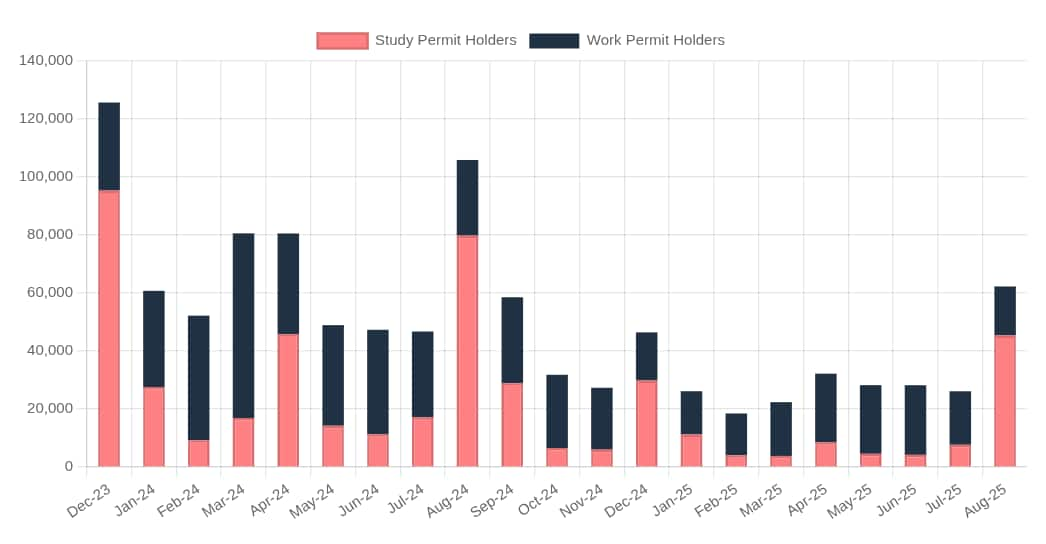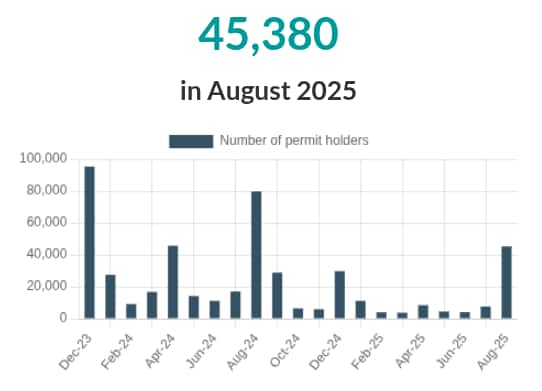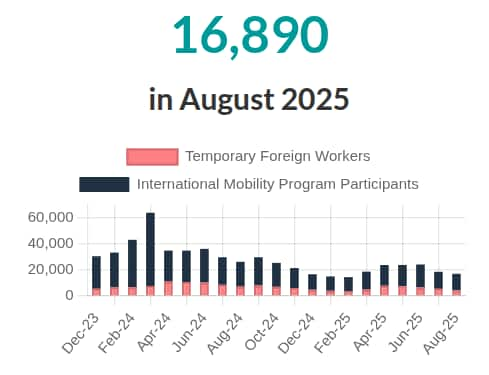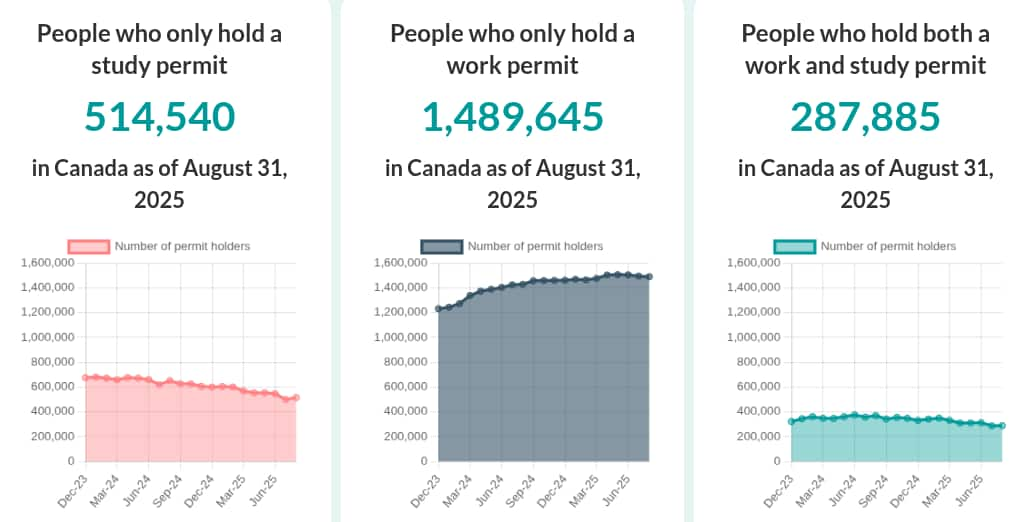Canada's New Immigration Policy: 60% Drop In International Students
Are you planning to study in Canada? You might need to reconsider for 2026! Canada has introduced a seismic shift in how the Immigration, Refugees and Citizenship Canada (IRCC) treats international students. The current immigration changes in Canada include new study permit caps, wage rules, and eligibility restrictions, and more. Canada is capping the international study permits with year-on-year further reductions, increased financial requirements, mandatory acceptance letter verification, and more, aiming to decrease its temporary population to less than 5%. The latest IRCC data shows major declines in both international student and foreign worker arrivals in Canada with such changes. Canada aims to reduce the number of international students and temporary workers through these measures, which can also help with housing, infrastructure, and service facilities.
This Story also Contains
- New Student and Temporary Worker Arrivals in Canada
- New Student Arrivals To Canada: Sharp Drop in Arrivals; 1,32,000 Fewer in 2025
- What it mean for Indian students planning to study in Canada for 2026?
- Changes in Canada's Immigration Policies: IRCC Steps in to Reduce Study and Work Permits
- Why is Canada reducing international Students and Temporary Workers?
- Challenges International Students Face Under Canada’s New Immigration Policy
- Sharp Drop in New Temporary Workers’ Arrivals in Canada
- Total Number Of Students And Temporary Workers In Canada
- Conclusion: Is Canada Worth It in 2026 Under New Immigration Policy?

We have mentioned complete details on how Canada faces a sharp drop in foreign student arrivals in 2025 due to the tightening of immigration rules. It also includes the latest and revised data released by IRCC on October 22, 2025, for the number of new students and workers arriving in Canada. The IRCC data shows a drop of 43.1% in international student arrivals, decreasing from 79,795 in August 2024 to 45,380 in August 2025. If you’re planning to study in Canada in 2026, you must read this article to make informed decisions.
Also Read:
New Student and Temporary Worker Arrivals in Canada
Check the image below to check the statistics about the international arrivals in Canada over the last year:

Source: Official (Number of New Students and Temporary Worker Arrivals in Canada)
New Student Arrivals To Canada: Sharp Drop in Arrivals; 1,32,000 Fewer in 2025
Many Indian students must have been planning to study in Canada in 2026. They must know the current number of international students in Canada and why the country has faced a major drop in international student arrivals in 2025.

Source: Official (Number of New student arrivals to Canada)
In August 2025, there were only 45,380 new student arrivals in Canada. This is the peak time when a significant number of international students take admission due to the fall intake in September-October. However, this year has seen around 43.1% less than the previous year, where 79,795 new student arrivals came in 2024. On the other hand, the total number of new international student arrivals was only 89,430 from January to August 2025, which is 132,505 fewer than last year. Check the table below for the number of international students who arrived in Canada in 2025:
Month | Study Permit Holders |
Jan-25 | 11,230 |
Feb-25 | 4,080 |
Mar-25 | 3,815 |
Apr-25 | 8,535 |
May-25 | 4,550 |
Jun-25 | 4,180 |
Jul-25 | 7,660 |
Aug-25 | 45,380 |
From January to June 2025, there were 88,617 fewer new student arrivals compared to the same period in 2024. Student permit-holders in Canada (only study permit) dropped from a Jan 2024 baseline to June 2025, the number fell by 133,325. The government’s target for new student arrivals in 2025 is 305,900, but by August 2025, only 29.24 % of that had been met. A major drop is seen from Indian students in getting student visas, with Canada tightening visa requirements.
Also Read:
What it mean for Indian students planning to study in Canada for 2026?
Generally, such a drastic drop in the number of students going to Canada shows that the country is either avoided by study abroad aspirants or it is very difficult to get in. Let us now check the points below to understand what this development of reducing foreign student numbers means for you:
It means competition is fiercer for study permits.
It means Canada is intentionally limiting intake.
It means foreign students are choosing other study abroad destinations with favourable immigration policies and streamlined processes.
Changes in Canada's Immigration Policies: IRCC Steps in to Reduce Study and Work Permits
Canada has introduced multiple changes in its immigration policies that affect international students. The main reasons behind these measures by Canada government are to reduce foreign students planning to enter Canada, aligning them to a sustainable level, which is less than 5%. Check the points below to understand Canada's immigration changes that are crucial for international students planning to study there in 2026:
New Caps on Canada study permits: For 2025 intake, Canada’s government has imposed a further cap limit, including a drop of 10% from the 2024 study visa cap.
Increased financial and eligibility checks: In order to get a Canada student visa, foreign students must comply with strict requirements amid current immigration policies. Major changes include university acceptance letter verifications and showing more funds to demonstrate financial capacity.
Changed Canada’s Post-Graduation Work Permits (PGWP) eligibility: Some programs become ineligible for a PGWP in Canada as per the rule imposed in 2025. A complete list of eligible courses is provided, and any other degree is not qualified for a work permit after graduation for international students.
India has been one of the largest source countries of international students to Canada, but with the immigration changes, 2025 is shaping up to be much tougher for them. Many Indian applicants for a Canada study visa now face harder scrutiny on acceptance letters, program quality, ability to fund studies, and post-study prospects.
Related Reads: Canada Student Visa Processing Time From India
Why is Canada reducing international Students and Temporary Workers?
Canada’s government aimed to decrease the number of foreign students and workers in Canada by 5% due to various reasons. Here are those key reasons to take steps like study caps, increased financial capacity, scrutiny, and more.
The government wants to bring the level of temporary residents, which are international students plus temporary workers, below 5 % of the total population, to attain sustainability
Housing, community services and infrastructure were under pressure from surging international student numbers.
A recalibration: the focus is shifting from volume of students to quality of entrants and alignment with labour-market needs.
Challenges International Students Face Under Canada’s New Immigration Policy
Check the points below to understand some of the major implications due to the changes in the immigration policies of Canada:
More Canada study visa rejection rates: A higher number of study visas are getting rejected for Canada from India because of the new caps and restricted eligibility criteria.
Program quality now matters more: Canadian universities and degrees that don’t meet the standard thresholds for PGWP eligibility might cost you your post-study work plans after graduation. Canada has provided a list of programs that are eligible for the PGWP, whereas many programs do not qualify.
Rising housing costs and unavailability: Canada has faced problems related to less available housing for living, along with the increasing cost of living. This has built high pressure for current international students and temporary workers in Canada. To solve such housing crisis in Canada, these measures were implemented, impacting a substantial number of foreign students there.
Job market uncertainties: With PGWP rules tightened and work-permit options less certain, many students worry: “Will I be able to stay and work?”. It has also been assumed that 30% fewer PGWPs are going to be offered till the end of 2025 amid the restrictive immigration policies in Canada.
Related Reads: Popular Medical Courses in Canada After 12th for Indian Students in 2025
Sharp Drop in New Temporary Workers’ Arrivals in Canada
With the current immigration restrictions, temporary workers in Canada number is also reduced. Temporary workers include all those who are currently on a work visa, and it is crucial to be aware of those who are planning to convert their Canada study permit to a work permit on graduation.
Basically, all international students who are going to convert their study visa to a work visa need to be aware of this drop. Canada government is focusing on providing job opportunities to those who are already in Canada rather than those who are planning to work in Canada through such measures.

Source: Official (Number of New Temporary Workers Arriving in Canada)
Month | Temporary Foreign Workers | International Mobility Program Participants |
Jan-25 | 3,895 | 11,005 |
Feb-25 | 3,320 | 11,070 |
Mar-25 | 4,795 | 13,750 |
Apr-25 | 7,750 | 15,890 |
May-25 | 7,470 | 16,205 |
Jun-25 | 6,470 | 17,555 |
Jul-25 | 5,420 | 13,030 |
Aug-25 | 4,195 | 12,695 |
As per the data released for August 2025, Canada has around 16,890 new temporary foreign worker arrivals, which is less than the previous number of 18,450.
Total Number Of Students And Temporary Workers In Canada
We have already discussed in detail the number of international student arrivals and the number of temporary worker arrivals in Canada above. Let us now check the charts below for comparing the total number of them over the years.

Source: Official (Total Number Of Study And Temporary Permit Holders In Canada)
Conclusion: Is Canada Worth It in 2026 Under New Immigration Policy?
Yes, Indian students can definitely consider studying in Canada in 2026, but with caution. If you go into this expecting the easy way into Canada like the old immigration system, it might not be the case for you. You need to be aware of the current immigration changes and how it is impacting the international students. This has also resulted in a decrease in the number of international student arrivals. Check the points below for more clarity on what things to consider while changing the immigration structure.
Canada remains a top destination in terms of top universities, global reputation, and potential post-study pathways.
But the rules have changed, which means these are becoming more and more strict for international students
Be updated about any other changes in Canada’s immigration to avoid last-minute hassle.
Frequently Asked Questions (FAQs)
A temporary worker is any individual who is not a Canadian citizen and is staying and working in Canada on a work permit or its equivalent. The Temporary Foreign Worker (TFW) Program in Canada is a law that allows these workers to fill temporary jobs when other Canadians are not available for the vacancy.
The number of temporary workers coming to Canada for work each year is not definite, as it varies as on the policies, applicants, and vacancies. As of August 2025, Canada has issued around 105,195 permits under the scheme of the Temporary Foreign Worker Program.
Canada is one of the top countries preferred for study, work, and permanent residency in many countries. The top 3 immigrant countries from where students and other professionals immigrate to Canada include India at the top, followed by China and the Philippines.
There are many jobs in demand that are quite popular in Canada for international students. These include registered nurses, software developers, civil and electrical engineers, and electricians. Traditionally, STEM-based jobs in Canada are always in demand due to the shortage of skilled labour in fields such as healthcare, technology, business, etc.
Questions related to
On Question asked by student community
Hello,
After completing BPT in India, you must get your qualification approved by the Canadian Alliance of Physiotherapy Regulators (CAPR) .
First, apply for credential assessment , then pass the written and clinical exams . You also need an English test score (IELTS or CELPIP) .
After clearing these, apply for a physiotherapy license in any Canadian province. Once licensed, you can apply for jobs or PR in Canada.
Some students also choose to do a Master’s in Physiotherapy in Canada for better job chances.
Hope it helps !
your career plan is valid as it provide knowledge which is relevant to become ips officer but you need to prepare for other subjects too because UPSC's ips broad syllabus includes Indian governance and current affairs too.
I advice to choose b.a in psychology in india as this avoids the need for an equivalency certificate after your graduation from canadian universities from the Association of Indian Universities (AIU) that is mandatory for foreign degrees.
But still if you want to prefer canadian degree then you can consider Simon Fraser University and the University of Windsor which offer a combined degree B.A. in Psychology and Criminology.
Hope it helps...
An undergraduate degree abroad is a good investment if you pursue it in canada because it provides quality education at affordable costs, along with a clearer path to post-graduation work and permanent residency,making it a reliable option to settle abroad.
Coming to U.S. it offers top-tier universities and higher salaries, but have very high costs and a difficult visa process for international graduates.
And if you are not sure go for studying in your home country which is more affordable and offering opportunities in a growing tech sector.
Ultimately, a strong focus on finances and long-term career plans, including any desire to immigrate, will guide your decision.
Good luck!!
After completing a BSc in Biochemistry, you can pursue various courses in Canada such as MSc in Biochemistry, Biotechnology, Molecular Biology, Pharmacology, or Clinical Research. These programs offer advanced knowledge and open opportunities in research, healthcare, and industry.
Hello,
Yes, you can pursue MD in Radiology in Canada after completing a B.Sc. in Radiology, but you need to complete a recognized medical degree (like MBBS) first. After that, you must pass the Medical Council of Canada Qualifying Examination (MCCQE) and complete a residency in radiology. Alternatively, you can explore postgraduate diploma or master’s programs in medical imaging or radiology if you wish to specialize without an MD.
Hope this helps you,
Thank you
https://www.careers360.com/courses/md-radiology
Applications for Admissions are open.
Want to study in Ireland? Explore Universities & Courses
Study in Canada
ApplyExplore Universities, Courses & Subjects | Work while study
Study in UK
ApplyApply for upcoming intake & plan your journey
Study in USA
ApplyUniversities inviting applications | Get expert guidance
Study in Australia
ApplyShortlist best ranked universities & get expert guidance